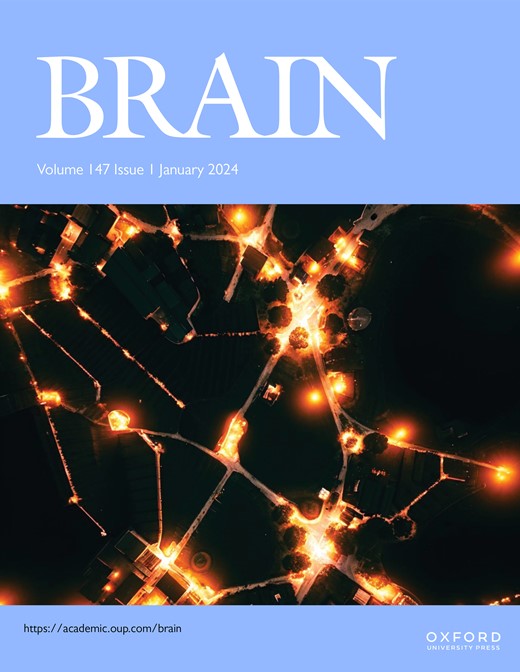A role for leucine-rich, glioma inactivated 1 in regulating pain sensitivity.
IF 10.6
1区 医学
Q1 CLINICAL NEUROLOGY
引用次数: 0
Abstract
Neuronal hyperexcitability is a key driver of persistent pain states including neuropathic pain. Leucine-rich, glioma inactivated 1 (LGI1), is a secreted protein known to regulate excitability within the nervous system and is the target of autoantibodies from neuropathic pain patients. Therapies that block or reduce antibody levels are effective at relieving pain in these patients, suggesting that LGI1 has an important role in clinical pain. Here we have investigated the role of LGI1 in regulating neuronal excitability and pain-related sensitivity by studying the consequences of genetic ablation in specific neuron populations using transgenic mouse models. LGI1 has been well studied at the level of the brain, but its actions in the spinal cord and peripheral nervous system (PNS) are poorly understood. We show that LGI1 is highly expressed in DRG and spinal cord dorsal horn neurons in both mouse and human. Using transgenic muse models, we genetically ablated LGI1, either specifically in nociceptors (LGI1fl/Nav1.8+), or in both DRG and spinal neurons (LGI1fl/Hoxb8+). On acute pain assays, we find that loss of LGI1 resulted in mild thermal and mechanical pain-related hypersensitivity when compared to littermate controls. In from LGI1fl/Hoxb8+ mice, we find loss of Kv1 currents and hyperexcitability of DRG neurons. LGI1fl/Hoxb8+ mice displayed a significant increase in nocifensive behaviours in the second phase of the formalin test (not observed in LGI1fl/Nav1.8+ mice) and extracellular recordings in LGI1fl/Hoxb8+ mice revealed hyperexcitability in spinal dorsal horn neurons, including enhanced wind-up. Using the spared nerve injury model, we find that LGI1 expression is dysregulated in the spinal cord. LGI1fl/Nav1.8+ mice showed no differences in nerve injury induced mechanical hypersensitivity, brush-evoked allodynia or spontaneous pain behaviour compared to controls. However, LGI1fl/Hoxb8+ mice showed a significant exacerbation of mechanical hypersensitivity and allodynia. Our findings point to effects of LGI1 at both the level of the DRG and spinal cord, including an important impact of spinal LGI1 on pathological pain. Overall, we find a novel role for LGI1 with relevance to clinical pain.富亮氨酸胶质瘤失活 1 在调节疼痛敏感性中的作用。
神经元过度兴奋是包括神经病理性疼痛在内的持续性疼痛状态的主要驱动因素。富亮氨酸胶质瘤灭活1(LGI1)是一种已知能调节神经系统兴奋性的分泌蛋白,是神经性疼痛患者自身抗体的靶标。阻断或降低抗体水平的疗法能有效缓解这些患者的疼痛,这表明 LGI1 在临床疼痛中发挥着重要作用。在此,我们利用转基因小鼠模型研究了特定神经元群基因消融的后果,从而研究了 LGI1 在调节神经元兴奋性和疼痛相关敏感性方面的作用。LGI1在大脑水平上的研究已经非常深入,但对其在脊髓和周围神经系统(PNS)中的作用却知之甚少。我们的研究表明,LGI1 在小鼠和人类的 DRG 和脊髓背角神经元中都有高表达。利用转基因缪斯模型,我们从基因上消减了 LGI1,无论是特异性地消减痛觉感受器(LGI1fl/Nav1.8+)中的 LGI1,还是同时消减 DRG 和脊髓神经元(LGI1fl/Hoxb8+)中的 LGI1。在急性疼痛试验中,我们发现与同卵对照组相比,LGI1 的缺失会导致轻微的热痛和机械痛相关超敏反应。在 LGI1fl/Hoxb8+ 小鼠中,我们发现 DRG 神经元的 Kv1 电流缺失和过度兴奋。在福尔马林试验的第二阶段,LGI1fl/Hoxb8+小鼠的痛觉行为显著增加(在LGI1fl/Nav1.8+小鼠中未观察到),LGI1fl/Hoxb8+小鼠的细胞外记录显示脊髓背角神经元兴奋性过高,包括发条增强。通过使用幸免神经损伤模型,我们发现 LGI1 在脊髓中表达失调。与对照组相比,LGI1fl/Nav1.8+小鼠在神经损伤诱导的机械过敏、刷诱发的异动症或自发疼痛行为方面没有表现出差异。然而,LGI1fl/Hoxb8+小鼠的机械过敏性和异动症明显加剧。我们的研究结果表明了 LGI1 在 DRG 和脊髓水平的影响,包括脊髓 LGI1 对病理性疼痛的重要影响。总之,我们发现了LGI1在临床疼痛中的新作用。
本文章由计算机程序翻译,如有差异,请以英文原文为准。
求助全文
约1分钟内获得全文
求助全文
来源期刊

Brain
医学-临床神经学
CiteScore
20.30
自引率
4.10%
发文量
458
审稿时长
3-6 weeks
期刊介绍:
Brain, a journal focused on clinical neurology and translational neuroscience, has been publishing landmark papers since 1878. The journal aims to expand its scope by including studies that shed light on disease mechanisms and conducting innovative clinical trials for brain disorders. With a wide range of topics covered, the Editorial Board represents the international readership and diverse coverage of the journal. Accepted articles are promptly posted online, typically within a few weeks of acceptance. As of 2022, Brain holds an impressive impact factor of 14.5, according to the Journal Citation Reports.
 求助内容:
求助内容: 应助结果提醒方式:
应助结果提醒方式:


